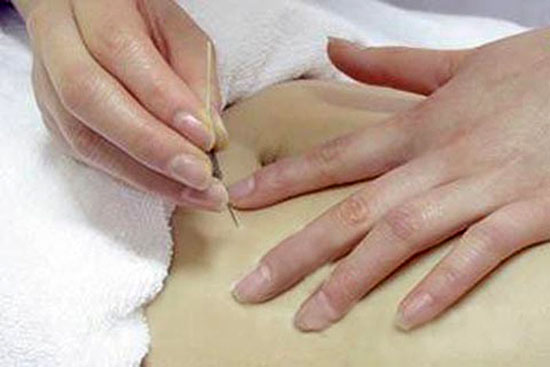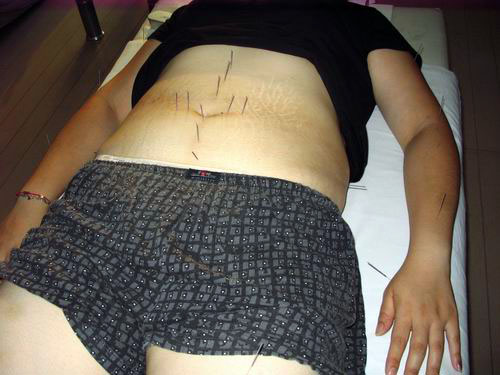Body acupuncture therapy a TCM therapy, is a method to promote the patient's somatopsychic rehabilitation by needling the acupoints properly selected according to the courses of meridians and collaterals with various needles. Body acupuncture therapy is extensively applied in clinic and plays an important role in health preservation, health care and rehabilitation of TCM. Now, the commonly-used methods are selectively and briefly introduced as follows.
1. Filiform needle therapy
The filiform needle is the most commonly-used instrument in acupuncture. The therapy has the actions of regulating visceral functions, qi flow and blood circulation, relieving pain, sedation, etc. It may be applicable to the disablement due to diseases and maim such as paralysis, convulsion, deafness and dumbness, various diseases during the convalescence such as palpitation due to fright, insomnia, and cough with dyspnea, thoracic obstruction, headache and thoracic fullness, various ageing diseases such as dementia, tremor and obesity.
The application of the filiform needle therapy should be strictly handled to avoid the contraindications. For example, needling is not advisable for patients with over-fatigue and starvation; strong stimulation is not advisable for patients with weak constitution; needling is not advisable in the case of skin infection and ulceration. Learn more information, please read Needling with Filiform Needles.

2. Therapy with the warming needle
The body of the needle is warmed in certain ways on the basis of therapy with the filiform needle in this therapy. It has the actions of activating yang to dispel cold, promoting qi flow and activating blood circulation.
There are many methods to heat the body of the needle. Generally, the ignited argyi wool and moxa roll or alcoholic cotton ball are used to lean against the handle of the needle, the duration and the temperature of which may be determined by the state of diseases. Therapy with the warming needle is mainly applicable to diseases due to asthenic cold or cold and dampness such as arthralgia due to cold and dampness, cold and pain of the waist and knees, pain due to asthenic cold of middle energizer. When using the warming needle, pay attention to the application and disposal of the fire source to prevent the injury. Learn more information, please read Preparations Prior to Treatment.
3. Therapy with the three-edged needle
This therapy has strong stimulation because it has to stab and wound the skin to bleed a bit. The commonly-used methods include spot pricking, clumpy pricking, and pricking, etc. Therapy with the three-edged needle has the functions of promoting blood circulation to remove blood stasis, inducing resuscitation and purging heat, etc. The method can be used for all the diseases with relatively obvious obstruction of meridians due to internal obstruction of blood stasis in TCM rehabilitation. It is commonly applicable to intractable Bi-syndrome, aphasia from apoplexy, numbness of limbs, intractable neurodermatitis, baldness and psoriasis.
The application of the three-edged needle requires aseptic manipulation. Besides, the action should be swift and the location shallow while profuse hemorrhage is not advisable. Do not injury the large arteries. Meanwhile, the patient should cooperate closely with the doctor to prevent fainting during acupuncture. This method is not advisable for patients with deficiency of qi and blood as well as frequent spontaneous hemorrhage or endless bleeding after injuries. Learn more information, please read the Three-edged Needles.

4. Electro-acupuncture therapy
Electro-acupuncture therapy, a method to promote rehabilitation, uses the electric stimulator to output a small amount of electric current approaching the bioelectricity of the human body which acts on the human body by means of the filiform needle inserted into the acupoint.
The indications of electrotherapy are basically the same as those of therapy with the filiform needle. It possesses better therapeutic effects on various painful diseases, paralysis, Bi-syndrome and abdominal mass, the dysfunctions of organs such as the heart, stomach, intestine, gallbladder and urinary bladder as well as the injuries of joints, muscles and ligaments, etc.
Before using the electric stimulator, check whether it functions well or not; for the electric stimulator with the maximum output voltage over 40 V, its maximum output current should be limited within 1 mA in order to avoid getting an electric shock; the electric current should be increased gradually and sudden increase is not allowed; for the patients with heart diseases, avoid the electric current passing through the heart; small amount of electric current is advisable on the regions near to the bulb and spinal cord; for pregnant women, it should be used with caution. Learn more information, please read Electro-Acupuncture Manipulations.
5. Hydro-acupuncture therapy
It is also called "acupoint injection". The therapy, a method to promote rehabilitation, uses the injection of drug into acupoints, tender points or sensitive points to regulate the functions of the corresponding viscera and tissues for the improvement of the pathological state by means of needling stimulation and the pharmacological actions of the drugs.
The proper syringe and syringe needle should be selected according to the differences of the location of the acupoints and the amount of the drug during the application of hydro-acupuncture therapy. For example, the syringe needle with size of 5 to 6.5 is selected for ordinary acupoints, while the syringe needle with the size of 9 is selected for deep acupoints, etc. During the injection, let the patient assume the comfortable posture. After the routine sterilization, insert the syringe needle with the liquid medicine quickly according to the angle and direction of inserting the filiform needle. Then, insert the needle deeper gradually. After the arrival of the needling sensation, if there is no blood in the syringe after it is drawn, push the liquid medicine into the acupoint. Learn more information, please read Scope and Cautions.
The commonly-used drugs: The injections of traditional Chinese medicines include injection of Danggui (Radix Angelicae Sinensis), injection of Honghua (Flos Carthami), injection of Chuanxiong (Rhizoma Ligustici Chuanxiong), injection of Danshen (Radix Salviae Miltiorrhizae), compound injection of Danggui (Radix Angelicae Sinensis), compound injection of Danshen (Radix Salviae Miltiorrhizae), compound injection of Huangqi (Radix Astragali Hedysari) and compound injection of Yuxingcao (Herba Houttuyniae).
The commonly-used injection of antibiotics of modern medicine includes injection of streptomycin, injection of kanamycin, injection of penicillin with procaine, injection of bleomycin, and injection of levomycetin, etc.; the drugs also include the injection of vitamins such as injection of vitamin B1, injection of vitamin B6, injection of vitamin B12, injection of vitamin B complex, injection of vitamin K3, injection of vitamin C and injection of vitamin E. Other types of drugs include injection of 0.25 to 2% procaine hydrochloride, injection of 25% magnesium sulfate, injection of atropine, injection of dexamethasone, injection of cortisone acetate, injection of Schaudinn scolloid calcium, injection of reserpine, injection of adrenosemsalicylate, and injection of 50% glucose, etc. Learn more information, please read Electro-Acupuncture Manipulations.
The dosage of acupoint injection is determined by the injection site, the property and concentration of the drug. Higher dose is applied on the site with thick muscle, generally 2 to 5 ml for one acupoint each time; smaller dose on the site with less muscle, usually 0.1 to 0.5 ml for one acupoint each time.
Hydro-acupuncture therapy may be applicable to various diseases such as every type of tissue damage, arthropathy, neuralgia, headache, insomnia, epilepsy, asthma, hypertension, cholelithiasis, hysteroptosis and allergic rhinitis. Points for attention.
① Have a good command of the properties, pharmacological actions, doses, expiry date, incompatibilities, side effects, allergic reactions of the medicine to be used. The skin tests should be done before the medicines which may produce allergic reactions are used such as penicillin; the drugs with strong side effects and irritability should be applied with caution. ② Avoid inserting the needle on the nerve trunks or puncture the part shallowly if the injection is to be done on the main nerve trunks in case the bad consequence should occur. ③ It is not advisable to inject the drug into blood vessels, articular cavities and cavities of spinal cord. Besides, hydro-acupuncture therapy is not advisable on the lower abdomen, waist, Sanyinjiao (SP6), Hegu (LI4), etc. in pregnant women.
6. Skin needle therapy
Skin needle is also called "plum-blossom needle" and "seven-star needle". It is a specially-made needle used to percuss the skin along meridians and collaterals or acupoints. Skin needle therapy, a needling method, applies such percussion to dredge meridians and collaterals and regulate visceral functions for the purpose of curing diseases.
The intensity of percussing acupuncture is divided into weak stimulation, moderate stimulation and strong stimulation. Weak stimulation refers to the appearance of flush on the percussed site and freedom from pain in the patient. It is applicable to the old, the weak, women and children as well as the parts of the head and face with shallow and thin muscles; strong stimulation means that blood oozes on the percussed site and that the patient feels painful.
It is applicable to the patients with strong physique and with sthenia syndromes as well as on the parts of limbs with rich and thick muscles; moderate stimulation, weaker than the strong one but stronger than the weak one, denotes that flush appears on the percussed site but no oozing of blood occurs, while the patient feels slightly painful. It is applicable to common chronic diseases.
The commonly-used methods of skin needle therapy include percussing along the meridian, percussing the acupoint, local percussing, etc. All these methods have better rehabilitation effects on insomnia, asthma, palpitation, headache, backache, lumbago, facial paralysis, skin numbness, neurodermitis or chronic eczema, alopecia areata, and flaccidity syndrome, etc.
Before using the skin needle therapy, the instruments should be carefully examined; aseptic manipulations are required; the therapy is not advisable to the patients with the ulcer or injury of local skin. Learn more information, please read Scope of Application.
7. Intradermal needle therapy
Intradermal needle therapy is also called needle-embedding therapy, of which the specially-made needle is inserted into the inside of the skin and retained for a certain period of time after the fixation. The therapy just makes use of such weak and persistent stimulation to promote the rehabilitation of diseases.
The duration of retaining the intradermal needle is determined by the specific state of disease. It usually lasts for 1 to 3 days, or for 6 to 7 days in long duration. During embedding the needle, press the site with the hand several times every day to strengthen the stimulation and therapeutic effects.
Intradermal needle therapy is mostly applicable to intractable diseases such as insomnia, asthma, hypertension, palpitation, headache, gastralgia, dysmenorrheal and bed wetting.
Pay attention to the sterilization when using intradermal needle therapy. Avoid water on the needle-embedded site in case infection should occur. In addition, it is not advisable to embed the needle on the part with skin ulcer as well as the parts which often move such as joints, the chest and abdomen. Withdraw the needle in case of discomfort after embedding the needle. Then, change to another site to embed the needle again. Learn more information, please read Manipulations and Cautions.







